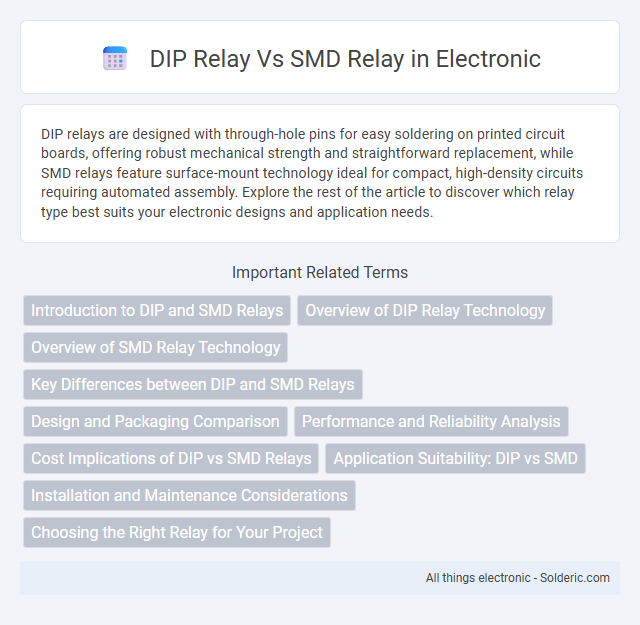DIP relays are designed with through-hole pins for easy soldering on printed circuit boards, offering robust mechanical strength and straightforward replacement, while SMD relays feature surface-mount technology ideal for compact, high-density circuits requiring automated assembly. Explore the rest of the article to discover which relay type best suits your electronic designs and application needs.
Comparison Table
| Feature | DIP Relay | SMD Relay |
|---|---|---|
| Mounting Type | Through-Hole | Surface Mount Device (SMD) |
| Size | Larger | Compact and smaller footprint |
| Assembly | Manual or wave soldering | Automated pick-and-place assembly |
| Applications | Prototyping, low-volume production, power circuits | High-density PCBs, mass production, space-constrained devices |
| Electrical Characteristics | Usually handles higher current and voltage ratings | Typically lower power ratings, but evolving with technology |
| Reliability | Good mechanical robustness | Enhanced reliability due to reduced solder joint stress |
| Cost | Generally lower unit cost, higher assembly cost | Higher unit cost, but lower assembly and production cost overall |
| Thermal Management | Better heat dissipation due to larger size | Requires careful PCB design for heat management |
Introduction to DIP and SMD Relays
DIP relays feature a dual in-line package with through-hole mounting, ideal for robust mechanical strength and easy manual soldering in traditional circuit boards. SMD relays, designed for surface-mount technology, offer compact dimensions and suitability for automated assembly processes in high-density electronic devices. The choice between DIP and SMD relays depends on space constraints, manufacturing methods, and application requirements in electronic design.
Overview of DIP Relay Technology
DIP relays feature a dual inline package with through-hole pins designed for mounting on printed circuit boards, offering robust mechanical strength and ease of manual soldering. These relays are known for their straightforward pin configuration and reliable switching capabilities, making them suitable for various industrial and automotive applications. Your choice between DIP and SMD relays depends on factors like assembly method, space constraints, and desired electrical performance.
Overview of SMD Relay Technology
SMD relay technology features surface-mounted devices designed for automated assembly processes, offering compact size and enhanced reliability over traditional DIP relays. These relays utilize semiconductor manufacturing techniques to achieve reduced parasitic elements, enabling faster switching speeds and lower power consumption. Their integration into modern electronic circuits supports miniaturization and improved performance in applications such as telecommunications, automotive systems, and consumer electronics.
Key Differences between DIP and SMD Relays
DIP relays feature through-hole mounting with an encapsulated plastic package, offering easy manual soldering and robust mechanical stability, whereas SMD relays utilize surface-mount technology designed for automated PCB assembly, enabling higher component density and faster production. DIP relays generally support higher current ratings and are favored in applications requiring mechanical strength, while SMD relays emphasize compact size and low profile, ideal for miniaturized electronic devices. The key differences lie in their mounting methods, size, mechanical durability, and suitability for automated manufacturing processes.
Design and Packaging Comparison
DIP relays feature through-hole design with dual in-line pins, making them ideal for prototyping and robust mechanical stability, while SMD relays utilize surface-mount technology for compactness and automated PCB assembly. The packaging of DIP relays is bulkier, suitable for larger, lower-density boards, whereas SMD relays offer smaller footprints and lower profile packages optimized for high-density and miniaturized electronic devices. Thermal management and electrical performance in SMD relay packaging benefit from closer proximity to the PCB, improving heat dissipation compared to the elevated positioning of DIP relays.
Performance and Reliability Analysis
DIP relays typically offer robust performance with higher insulation resistance and better suitability for applications requiring greater mechanical durability, while SMD relays excel in compactness and ease of automated assembly, enhancing reliability in high-density PCB designs. Reliability analysis shows DIP relays withstand higher shock and vibration levels, making them ideal for industrial environments, whereas SMD relays provide improved electromagnetic compatibility and thermal performance due to lower parasitic inductance and reduced solder joint stress. Both relay types demonstrate comparable contact life spans, but SMD relays benefit from modern manufacturing techniques that reduce failure rates in surface-mount applications.
Cost Implications of DIP vs SMD Relays
DIP relays typically incur higher manufacturing and assembly costs due to their larger size, manual handling requirements, and through-hole mounting process. SMD relays benefit from automated surface-mount technology, reducing labor expenses and improving production speed, which lowers overall costs in high-volume applications. Cost efficiency of SMD relays makes them more suitable for compact, cost-sensitive electronics, whereas DIP relays may be preferred in low-volume or specialized repair scenarios despite their increased expense.
Application Suitability: DIP vs SMD
DIP relays are ideal for applications requiring easy manual inspection and replacement, such as prototyping or low-volume production, due to their through-hole mounting and robust design. SMD relays suit high-density circuit boards and automated manufacturing, offering compact size and better performance in space-constrained environments like smartphones and wearable devices. Your choice between DIP and SMD relays largely depends on production scale, assembly process, and available PCB space.
Installation and Maintenance Considerations
DIP relays require manual soldering and are easier to replace individually, making them suitable for prototyping and low-volume production, while SMD relays are surface-mounted, enabling automated installation for high-volume manufacturing but complicating manual repairs. Your choice depends on the available equipment and maintenance preferences, as DIP relays allow straightforward troubleshooting and replacement, whereas SMD relays demand reflow soldering techniques and often specialized tools. Considering these factors ensures efficient installation and long-term maintenance aligned with your production scale and service capabilities.
Choosing the Right Relay for Your Project
Choosing the right relay for your project depends on factors such as space constraints, mounting preferences, and electrical requirements. DIP relays are suitable for through-hole mounting and provide robustness in mechanical stability, making them ideal for prototyping and applications with higher mechanical stress. SMD relays offer a compact footprint with surface-mount technology, enabling automated assembly and higher component density on PCBs, which is advantageous for modern, miniaturized electronic devices.
DIP Relay vs SMD Relay Infographic

 solderic.com
solderic.com